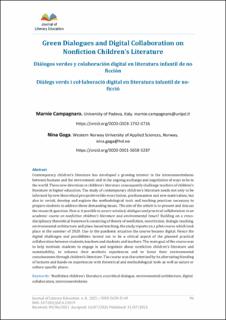| dc.contributor.author | Campagnaro, Marnie | |
| dc.contributor.author | Goga, Nina | |
| dc.date.accessioned | 2021-10-12T13:42:19Z | |
| dc.date.available | 2021-10-12T13:42:19Z | |
| dc.date.created | 2021-08-04T10:00:14Z | |
| dc.date.issued | 2021 | |
| dc.identifier.citation | Campagnaro, M., & Goga, N. (2021). Green dialogues and digital collaboration on nonfiction children’s literature. Journal of Literary Education, 4, 96–114. | en_US |
| dc.identifier.issn | 2659-3149 | |
| dc.identifier.uri | https://hdl.handle.net/11250/2789382 | |
| dc.description.abstract | Contemporary children’s literature has developed a growing interest in the interconnectedness between humans and the environment and in the ongoing exchange and negotiation of ways to be in the world. These new directions in children’s literature consequently challenge teachers of children’s literature in higher education. The study of contemporary children’s literature needs not only to be informed by new theoretical perspectives like ecocriticism, posthumanism and new materialism, but also to revisit, develop and explore the methodological tools and teaching practices necessary to prepare students to address these demanding issues. The aim of the article is to present and discuss the research question: How is it possible to secure scholarly dialogue and practical collaboration in an academic course on nonfiction children’s literature and environmental issues? Building on a cross-disciplinary theoretical framework consisting of theory of nonfiction, ecocriticism, dialogic teaching, environmental architecture and place-based teaching, the study reports on a pilot course which took place in the summer of 2020. Due to the pandemic situation the course became digital. Hence the digital challenges and possibilities turned out to be a critical aspect of the planned practical collaboration between students, teachers and students and teachers. The main goal of the course was to help motivate students to engage in and negotiate about nonfiction children’s literature and sustainability, to enhance their aesthetic experiences and to foster their environmental consciousness through children’s literature. The course was characterized by its alternating blending of lectures and hands-on experiences with theoretical and methodological tools as well as nature or culture specific places. | en_US |
| dc.language.iso | eng | en_US |
| dc.publisher | Universitat de València | en_US |
| dc.rights | Navngivelse 4.0 Internasjonal | * |
| dc.rights.uri | http://creativecommons.org/licenses/by/4.0/deed.no | * |
| dc.title | Green Dialogues and Digital Collaboration on Nonfiction Children’s Literature | en_US |
| dc.type | Journal article | en_US |
| dc.description.version | publishedVersion | en_US |
| dc.rights.holder | © 2021 The Author(s) | en_US |
| dc.subject.nsi | VDP::Humaniora: 000::Litteraturvitenskapelige fag: 040 | en_US |
| dc.source.pagenumber | 96-114 | en_US |
| dc.source.volume | 4 | en_US |
| dc.source.journal | Journal of Literary Education | en_US |
| dc.identifier.doi | 10.7203/JLE.4.21019 | |
| dc.identifier.cristin | 1923777 | |
| cristin.ispublished | true | |
| cristin.fulltext | original | |

